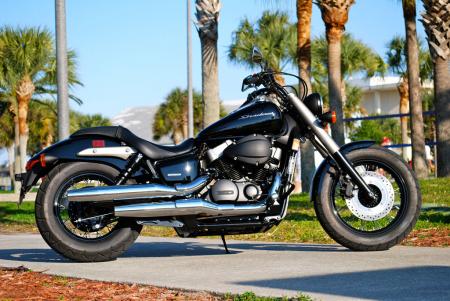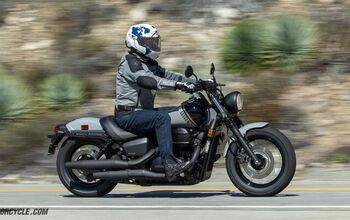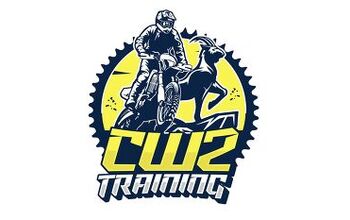2010 Honda Shadow Phantom Review - Motorcycle.com
At one point during our testing of the 2010 Honda Shadow Phantom at this year’s Daytona Bike Week, we parked the raked-out, V-Twin cruiser in a long line of Harley-Davidsons on Beach Street just for fun.
On a quick glance, it nearly looked like it belonged as part of the family – at least a not-so-distant cousin.
But even with its blacked out, ready for-the-boulevard looks, on closer inspection this motorcycle unmistakably remains a Honda.
For one, the shaft final drive is an immediate visual giveaway. And within its 52-degree, long-stroke 745cc engine, there are no pushrods. Instead, a single overhead cam operates two intake valves and a single exhaust valve. New to the engine is a fuel-injection system delivering the air-fuel mixture to each cylinder, while twin spark plugs per cylinder ensure efficient combustion.
The exhaust note is tuned to serve up a suitably aggressive rumble, the way cruiser fans like it, but unless you are tone deaf, you probably would not mistake it for the distinctive sound of a genuine 45-degree Harley.
These observations aside, this latest version of a design first penned in 1983 has definitely evolved one step closer to the intimidating look, sound and feel of something from the H-D brand, while ironically producing a bike with very little intimidation factor for the rider.
Take, for example, its 25.7-inch seat height. It was a bit too low for my 34-inch inseam, but shorter riders and those just starting out will find this a benefit. New riders who are on the taller side may yearn for a bit more legroom, but the low seat height otherwise makes the bike less daunting to ride.
Likewise, the programmed fuel injection (PGM-FI) adapted to the formerly carbureted mill makes for easy start-up and reliable power delivery. Its single 34mm throttle body meters the combustible mix well.
The engine provides enough grunt for the 549-pound machine to leave a stop light in enough of a hurry to easily outpace most automotive traffic, and its wide-ratio five-speed transmission is long-legged enough to travel the interstate if you are so inclined.
In fact, if you added a windscreen and saddlebags, this mid-sized iron horse could be ready to run through a few states or more, and ought to do it fairly reliably, if not sparsely.
But its primary design goal, as mentioned, is to sweeten the eye candy for those whose tastes favor the evergreen American Cruiser style. And it is that image to which this Honda unabashedly pays homage, as the company continues to carve its slice from the cruiser market-share pie. Getting a piece of the action is further made possible by the Shadow Phantom’s fairly reasonable MSRP of $7,999.
But again, though it may be considered entry level, this bike basically delivers. It rides on fairly beefy non-adjustable 41mm forks offering 4.6 inches of travel, while the rear is held up by dual shock absorbers offering 5-position preload adjustability and 3.5 inches of travel.
Braking duties are delegated to a rear drum and a single 296mm front rotor pinched by a twin-piston caliper. While Spartan by the standards offered by more high-performance bikes, these binders nevertheless provide the power expected from a cruiser.
On the road, the front brakes were able to squeal the tire to the point of lockup at highway speed for my 185 lbs. I’d say this is at least adequate. The feeling at the lever was firm and predictable, too.
The aforementioned tire squealing represented a protest from an otherwise fairly grippy 120/90-17 Bridgestone front tire. The rear tire is a 160/80-16. While the fat Japanese rubber-Os have a name reminiscent of a headache remedy – “Exedra” – they were just what the doctor ordered when it comes to adequate traction.
The result is experienced riders will find themselves encouraged to lean this machine over until solid bits start to scrape. The replaceable steel feeler nubs on the forward-positioned footpegs of our demo bike had already been nearly abraded to nothing after just over 1,000 miles.
You can interpret this any way you like. Critically, you could say this bike – like a lot of cruisers – lacks ground clearance for cornering, which performance-oriented riders view as a negative. But really, many cruiser riders are less concerned about ground clearance and might rarely if ever scrape hard parts. But if they do – and to put a positive spin on it – new riders especially will learn there is definite feedback well before the bike gets overly horizontal and in danger of a low-side crash.
In short, the Shadow Phantom offers appliance-like operability that should encourage anyone, even beginners, to explore the bike’s capabilities without excessive fear that a mistake on their part could end too easily with them on the ground.
The handling is reasonably neutral, and the transmission is easy to snick up and down the gear range. The clutch engagement point was a bit far out, which might present a slightly less user-friendly interface for a new rider, but it was not enough to be a true red flag.
The bike’s styling is rounded out by a tank-mounted speedometer (no tachometer), along with a one-piece “gunfighter” style saddle.
And just like another entry-level vehicle of years past, the Ford Model T automobile, you can have the Shadow Phantom in any color you like, as long as it’s black. Black is the new black, as evidenced by Harley’s success with its Dark Custom series. Honda hopes its newly blacked-out cruiser will offer worthy competition to others in its category.
“The Phantom offers turnkey bad attitude and bare bones looks, yet a potential customer can still be assured of the legendary Honda quality underneath this Shadow’s tough guy veneer,” exclaimed Pete about the new Honda Shadow.
We were not able to ride 2010 versions of competitive bikes, or compare them to the Honda back-to-back, but a few worth comparing to the Shadow Phantom could be the Star V Star 950, the Suzuki Boulevard M50, the Kawasaki Vulcan 900, and even the H-D Sportster 883, although Honda’s 2010 Shadow RS is more a head-to-head competitor to the 883, and we may pair up those two in the near future.
These V-Twin boulevard bikes share the common denominator of fuel injection, similar style, power, and weight.
The mid-weight/quasi-entry-level cruiser class is highly competitive, but after sampling this freshly-updated Honda, we would speculate it should hold its own and offer one more viable option to would-be buyers.
Related Reading
First Ride: 2007 Honda Shadow Spirit 750 C2
2010 Honda Fury Review
2009 Honda VTX1300T Review
2009 Star V Star 950 Review
2009 Suzuki Boulevard M50 Review
2009 Kawasaki Vulcan 900 Review
2009 Harley-Davidson Iron 833 Review
All Things Honda on Motorcycle.com
More by Jeff Cobb

































Comments
Join the conversation